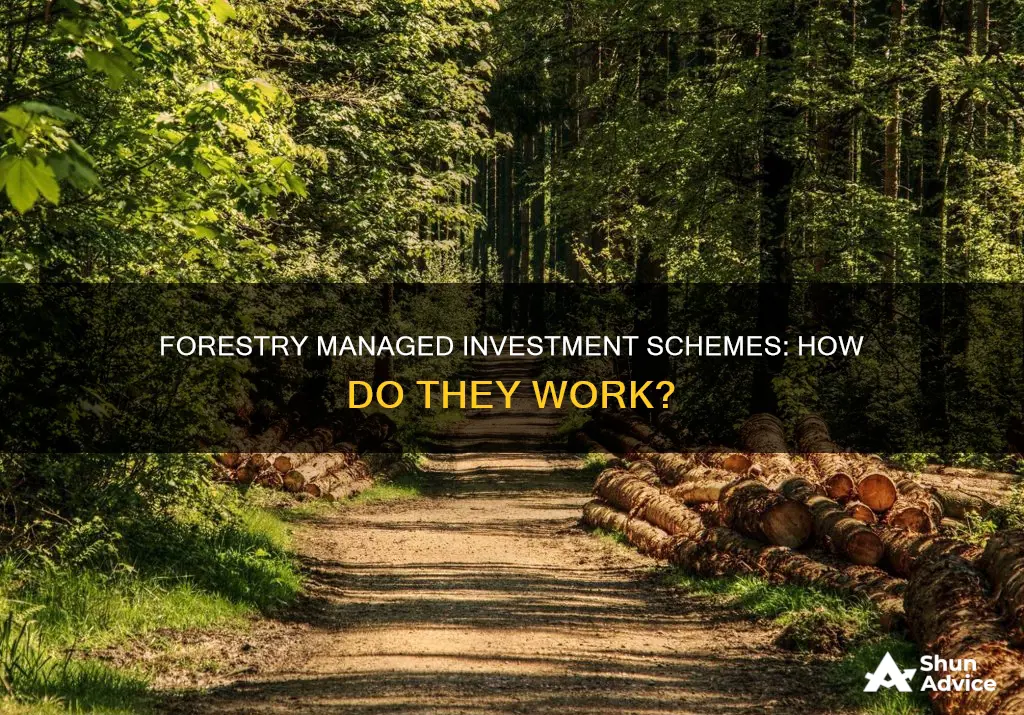
Forestry managed investment schemes (MIS) are a type of agribusiness investment that involves establishing and tending trees for felling. These schemes are designed to encourage the expansion of commercial plantation forestry, with investors treated as primary producers carrying on a business in agriculture, forestry, or horticulture for income generation. The Australian government has implemented rules and regulations to promote transparency and protect investors, including allowing trading of interests and imposing administrative requirements on promoters. However, there have been instances of such schemes collapsing, resulting in significant losses for investors.
| Characteristics | Values |
|---|---|
| Purpose | Establishing and tending trees for felling |
| Investor Types | Initial participants and subsequent participants |
| Tax Treatment | Investors are treated as primary producers carrying on a business in agriculture, forestry or horticulture for the purpose of generating income |
| Tax Efficiency | The investments are structured so that the majority of the investment is tax-deductible |
| Trading | Investors can trade their interests after being held for more than four years |
| Requirements for Qualifying Schemes | Reasonable expectation that direct forestry expenditure will equal or exceed 70% of contributions by investors; Trees must be established within 18 months of the end of the income year in which an investor first pays |
What You'll Learn

Tax benefits and consequences
Forestry managed investment schemes (MIS) are a type of agribusiness investment that involve establishing and tending trees for felling. These schemes typically offer tax benefits to investors, who are treated as primary producers by the Australian Taxation Office (ATO). This means that investors in forestry MIS can claim tax deductions on their contributions, either in the first year or spread out over several years. For example, a $10,000 investment could result in a $4,700 tax refund for an investor in the top tax bracket of 47%.
However, there are also tax consequences to consider when investing in a forestry MIS. For instance, if the scheme is terminated early, there may be tax implications for participants. Additionally, investors who sell their interests in the scheme within four years of acquiring them may no longer be entitled to the tax deductions they initially claimed. They may also be liable for interest and penalties on any tax underpaid as a result.
To be considered a qualifying scheme, the forestry manager must demonstrate that at least 70% of investor contributions will be spent on direct forestry costs during the life of the project. This is known as the 70% direct forestry expenditure rule. The forestry manager must also notify the ATO when they first receive income from a forestry MIS and provide documentation showing how the scheme satisfies the 70% rule.
It is important for investors to carefully investigate any schemes before investing and to be cautious of schemes that promise substantial tax benefits. Seeking independent financial advice before signing up for a forestry MIS is recommended by the Australian Securities and Investments Commission (ASIC).
Saving and Investing: Reddit's Money-Wise Wisdom
You may want to see also

Types of investors
A forestry managed investment scheme (MIS) is a type of agribusiness investment that focuses on establishing and tending trees for felling. These schemes are designed to encourage the expansion of commercial plantation forestry, and they offer tax benefits to investors. There are two types of investors in a forestry MIS: initial participants and subsequent participants.
Initial participants are those who invest directly in the forestry manager of a qualifying scheme, and their payments result in the establishment of trees. They can claim immediate deductions for their contributions in the year they make them. To be considered a qualifying scheme, the forestry manager must show that at least 70% of investor contributions will be spent on direct forestry costs and that the plantation will be established within 18 months of the end of the income year in which the first payment is made.
On the other hand, subsequent participants acquire their interests through secondary market trading, usually by purchasing from initial participants. They cannot claim deductions for their acquisition costs but can deduct expenses like lease fees, annual management fees, and costs of felling.
Forestry MIS have become popular investment options, as they are very tax-efficient, with the majority of the investment being tax-deductible. However, it is important for investors to carefully investigate schemes before committing, as there are risks involved, including the potential for the scheme to fold or fluctuations in returns due to unpredictable factors such as weather and demand.
The Investment Savings Curve: A Guide to Financial Strategy
You may want to see also

Qualifying scheme requirements
To be considered a qualifying scheme, the forestry manager must meet the following requirements:
- Reasonable Expectation Test: There should be a reasonable expectation that direct forestry expenditure for the scheme will equal or exceed 70% of contributions by investors at the end of the financial year in which an investor first contributes to the scheme. This means that at least 70% of investor contributions are used for direct forestry costs during the life of the project.
- 70% Direct Forestry Expenditure Rule: Direct forestry expenditure (DFE) refers to costs directly related to establishing, tending, felling, and harvesting trees. The scheme must ensure that no less than 70% of investor funds are allocated for DFE over the entire duration of the project. If the transaction is not at arm's length, the market value will be considered instead of the actual prices used in determining DFE when the amount paid by the forestry manager deviates significantly from the market value.
- Calculating Net Present Value: When calculating the net present value of all costs for the DFE calculation, future costs can be adjusted by the consumer price index (CPI). The Australian Bureau of Statistics publishes CPI rates, and the Australian Taxation Office (ATO) reproduces these figures based on 'All groups CPI-weighted average of eight capital cities'. The discount rate used for net present value calculations is based on the yield of Australian Government Securities (Treasury bonds) with a maturity closest to 10 years, as published by the Reserve Bank of Australia.
- 18-Month Establishment Rule: Trees must be established within 18 months from the end of the income year in which an investor first contributes to the scheme. If this deadline is not met, the forestry manager must provide a statement explaining the reasons for the delay within three months after the 18-month period ends.
These requirements are essential for a forestry managed investment scheme to be considered a qualifying scheme, allowing investors to claim upfront deductions for their acquisition costs and subsequent contributions.
Understanding Portfolio Investment: Definition and Key Concepts
You may want to see also

Trading restrictions
There are several trading restrictions to be aware of when it comes to forestry managed investment schemes (MIS). Firstly, only initial investors in a forestry MIS can trade their interests, and they must have held those interests for at least four years. This four-year restriction applies only to the initial investors and not to subsequent investors who acquired their interests through secondary market trading.
If an initial participant sells their forestry interest within four years, they will no longer be entitled to a deduction for the amount paid for their interest, including any amount they may have already claimed in previous years. They will still be assessed on the proceeds of the sale and may be liable for interest and penalties on any tax underpaid as a result. However, if the disposal of the interest is due to circumstances outside the investor's control, such as compulsory acquisition, insolvency, or natural disasters, a deduction will still be allowed.
Forestry managers must notify the Australian Taxation Office (ATO) when they first receive income from a forestry MIS and document the basis on which the scheme satisfies the 70% direct forestry expenditure rule, which requires at least 70% of investor contributions to be spent directly on forestry development. If the trees are not established within 18 months, the forestry manager must notify the ATO and provide a statement explaining the reason for the delay.
The ATO enforces holding period rules for forestry MIS investors, and promoters of the scheme must notify the ATO when they first receive income to ensure the office is aware of all industry participants.
It is important to note that investors should investigate any schemes before investing and be cautious of schemes that promise substantial tax benefits. Seeking independent financial advice before signing up for an investment is recommended by the Australian Securities and Investments Commission (ASIC).
Building an Ally Investment Portfolio: A Guide
You may want to see also

Promoter requirements
If you are a promoter, arranger, or manager of a forestry managed investment scheme (MIS), you cannot be a participant in that scheme. It is your responsibility to ensure that your MIS meets the requirements of a qualifying scheme so that investors can get upfront deductions for their acquisition costs and subsequent contributions.
To be considered a qualifying scheme, the forestry manager needs to show that there is a reasonable expectation that at least 70% of investor contributions will be spent on direct forestry costs during the life of the project. This is known as the 70% direct forestry expenditure rule, and it is a requirement that must be met for a scheme to qualify. Direct forestry expenditure refers to costs directly related to establishing, tending, felling, and harvesting trees.
Additionally, as a promoter, you must notify the Australian Taxation Office (ATO) when you first receive income from a forestry MIS to ensure they are aware of all industry participants. You must also document the basis on which the scheme satisfies the 70% direct forestry expenditure rule. If the trees are not established within 18 months, you are required to notify the ATO and provide a statement explaining why.
Building a Diverse Investment Portfolio: Strategies for Success
You may want to see also
Frequently asked questions
A forestry managed investment scheme (MIS) is a type of agribusiness investment scheme that involves establishing and tending trees for felling.
Forestry MIS offer tax benefits to investors, treating them as primary producers and offering tax deductions for contributions.
There are several risks associated with investing in forestry MIS, including the potential for the scheme to run out of money and fold, unexpected additional costs, and unpredictable returns due to weather, demand, and price fluctuations.
Initial participants are those who obtain their forestry interest directly from the forestry manager and can claim immediate deductions for their contributions. Subsequent participants acquire their interest through secondary market trading and cannot claim deductions for acquisition costs.
To be considered a qualifying scheme, the forestry manager must demonstrate a reasonable expectation that at least 70% of investor contributions will be spent on direct forestry costs during the life of the project, and the plantation must be established within 18 months of the end of the income year in which the first investment is made.







